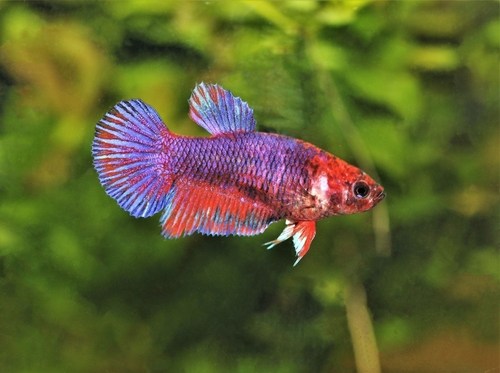
Considering that more than 73 recognized species of betta fish exist today, this tropical wonder is anything but plain. Betta fish have a strong reputation among aquarium enthusiasts thanks to their lively colors. So when you notice your betta fish losing color, you know that there’s likely something wrong.
The most popular form of bettas is known as the Siamese fighting fish. These bettas sport gorgeous fins that flow with the water, creating a dance-like movement. Unfortunately, with all the beauty the betta fish species have to offer, they are also susceptible to conditions that can strip them of their gracious physical attributes. As a result, bettas can sometimes begin to lose the colors they are born with, beginning to appear black or white.
There’s no singular reason for this, and a betta fish losing color can sometimes be a sudden occurrence. However, if you’re dealing with this problem, it might be time for you to look at the reasons we’ve compiled below.
In this article, we’ve presented some of the possible scenarios that can change your betta’s appearance. So, if you have a betta fish turning ‘black or white,’ it’s time to figure out why!
How Color Works With Betta Fish
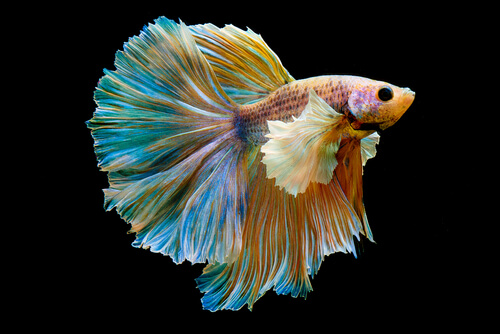
Aquatic friends like bettas result from unique genetics that creates their extraordinary appearance. Whether due to its environment or selective breeding, your betta can be born in any color you’re attracted to. So if you chose a betta due to its color and suddenly notice changes in its appearance, it would be understandable if you’re concerned. But it’s not always something to worry about.
Many scenarios can induce this change of some bettas darkening and others whitening. However, the most common reasons behind the change in color can be summed up as environmental changes. Here are some of the popular ones.
1. Stress
A betta fish losing color can be commonly traced to stress. Surprising? No. Although domestic fish live pretty relaxed lives in aquariums, environmental factors are vital in determining their moods. The general well-being of a betta fish can be summed up to its diet and environment. Therefore, you should actively track your tank’s temperatures and water conditions. Apart from changing colors, a betta fish not moving is another symptom of stress that can go unnoticed without regular tank checks.
In the grand scheme of betta care, you’ll find new things stressing your fish all the time. For example, injuries, the introduction of new fish, and new environments all play a part. So you’ll always have to watch out for these things during their lifetime.
When a female betta is stressed, they tend to develop stress stripes which are horizontal lines that appear along its body. Their color changes, possibly involving the betta fish turning black or white. If the stripes on a female betta appear dark or light, it indicates that your female betta is preparing to breed.
2. Genetics
Certain betta fish tend to undergo color changes during their lifetimes. These are known as marble betta fish. They possess jumping genes that make it unpredictable to know what color they might change to. Sometimes, they stay the same, change patterns, or transform to a neutral color. A marble betta fish turning black or white isn’t unheard of.
The distinction between jumping genes and an aging or stressed betta is down to the vibrancy of its colors. There can be moments during the transition where a marble betta appears washed out.
If you’re unsure, inquire at the pet shop you bought your betta from. If it turns out that you own a marble, ensure that your tank conditions are safe. This way, you’ll never need to worry when it begins transitioning.
3. Old Age
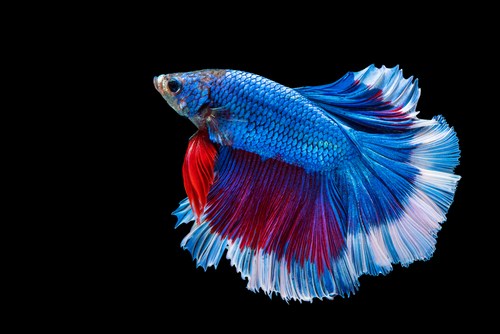
It’s no surprise that aging comes with its complications. Bettas begin to lose color as they approach the end of their life. This is a natural part of the aging process. An aging betta fish not moving as much is also a natural symptom of the process. If a betta survives for up to five years, expect and embrace these changes.
Sometimes, age-related color differences can begin when a betta is only two years old. If your betta is around that age, you should attempt to reduce stress in its surroundings, encouraging less fading and giving it more time to enjoy its remaining life.
4. Injury
Sometimes, bettas are highly distressed by injuries, especially when their immune systems begin to feel the presence of the secondary effects. For example, bacterial infections can be dangerous to your fish and can easily cause your betta fish to lose color.
One type of injury that changes your betta’s colors is fin rot. This one is primarily manifested in the fins of a betta. If a betta fish is suffering from its effects, the edges of its fins will begin to look different. Turning black, white, or even brown. It is relatively easy to detect the impact of fin rot on a betta, so you should be ready with reactive treatments if you spot the infection. However, it might be too late if you notice your betta fish not moving after leaving fin rot untreated.
Fin rot can result in your betta fish turning black or white, so be sure to look closely at its appearance. Sometimes, a betta actively healing from an injury will have a darker shade when the affected part begins to regrow. However, you shouldn’t be worried in this case, especially when your tank is clean and water parameters are safe.
Why Is My Betta Fish Turning Black?
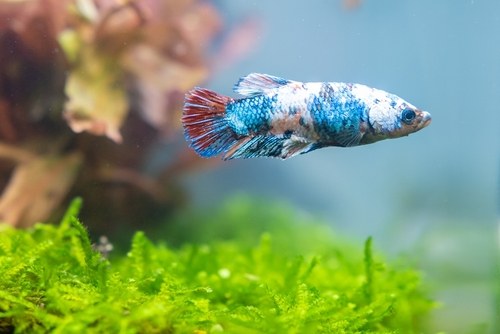
There have been moments when betta owners spotted a darkening hue on their fish. In this case, don’t jump into panic mode. It might just be a sign that your fish is in the process of maturing. If you own a marble betta, you will likely see this due to its genetics.
If those are not the reasons, then your betta could be showing signs of stress. A betta fish not moving while turning black is also not a good sign. Be sure to check on it and solicit advice from a veterinarian.
Why Is My Betta Fish Turning White?

A transition into a white color for betta fish can represent a serious problem compared to one that is turning black. Therefore, if you notice this change, look for any of the issues described below.
1. Ich
These are white spots that are caused by a parasite. Skin infection begins when the “Ichthyopthirius multifilis” parasite invades a bettas body.
White spots can begin to appear, causing effects such as your betta fish losing color. Another side-effect of this condition is your betta fish not moving. Once you’re aware that you’re dealing with Ich, it’s time to act. If caught early enough, the condition can be cured quite easily. Immediate treatment is needed, but you should consult a veterinarian if the situation does not ease up.
2. Columnaris
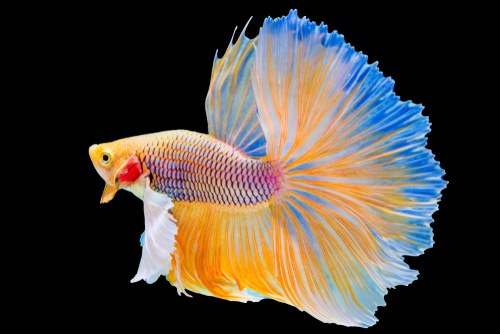
This bacterial infection is one that can drastically change the appearance of your betta. Certain parts of its body can begin turning white, giving it a fluffy look. In addition, its fins may start to fray, along with ulcers and sores occurring along the body.
Columnaris can be dangerous if left unattended, but it is entirely treatable. The early stages are not difficult to spot, so you should quarantine your fish and lower the temperature in the tank to make it harder for the bacteria to survive. Follow this up with the necessary medication.
3. Anchor Worms
When your betta suffers from anchor worms, its skin color may appear white. However, you can mistake anchor worms as a transition in color for your betta fish due to their whiteness. The infection can be spotted easily in your fish. You will notice ulcers, lethargy, rubbing, and scraping against objects.
Treating anchor worms can be done by removing the worms using tweezers. In addition, adding potassium permanganate to their tank is also helpful to your bettas. This substance can help to disinfect the parasites and bacteria.
How To Improve The Color Of Your Betta
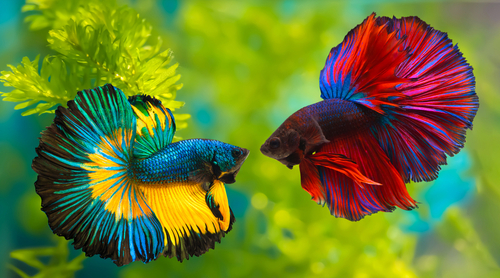
If you’re tired of your betta fish turning black or white, it might be time to make some changes to your routine. Of course, this will take effort on your part. However, diligent care can ensure that your betta will only experience color changes naturally.
1. Improve Tank Conditions
The first thing that should come to your mind when taking care of fish is the tank. As your betta fish’s primary housing, a tank has to be a home worth living in for them. If you have a single betta, you should try to keep it in a 5-gallon tank.
Adverse health effects can manifest when a tank is overcrowded, including your betta fish losing color. Also, adding plants in a betta tank is an excellent way to create a natural filter that can absorb toxins and reduce their presence in the water.
2. Diet
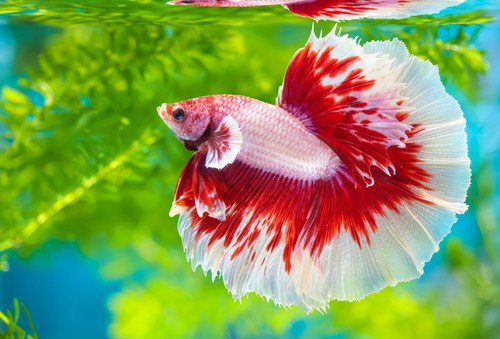
A healthy betta must have a generous dose of protein in its diet. Be sure to include new elements like salmon and brine shrimp as a part of its diet. This way, you can successfully enhance the vivid hue of its natural color. Be sure to feed using the recommended 12 hours between meals.
When bettas enjoy a richer diet, they can become livelier after feeds, allowing their graceful fins to flow. You’ll even get to enjoy a taste of their bright personalities once they are well-fed and happy! Watching as your betta begins to fulfill its potential in appearance is a joy, rather than a betta fish losing color. A good diet can enhance its color even more than what you initially saw in the tank during your purchase.
3. Feed Your Betta Fish Color-Enhancing Foods
With some experimentation over the years, certain aquarium enthusiasts have noticed that some food choices can affect the pigment of a betta fish.
- Salmon: This is a common food choice for improving the color of your betta. You can cut it into tiny pieces along with other fish food.
- Daphnia: This is a beautiful choice for pigment, as crustaceans have been noted to improve the color of bettas over the years. Daphnia, in particular, contains carotenoid pigments. This pigment directly affects the quality of your betta’s color.
4. Temperature And Water Parameters
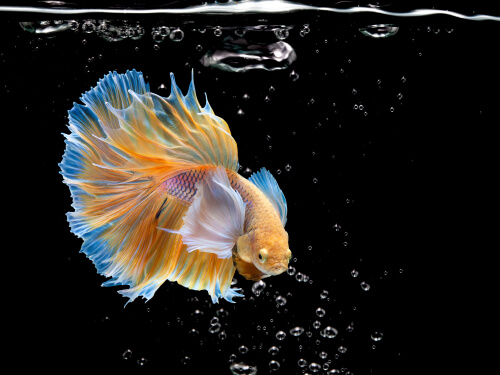
The ideal water temperature for bettas sits between 76 to 82 degrees Fahrenheit, so you should use that as your guide when adjusting your tank parameters. Maintaining this temperature requires a combination of due diligence, a digital thermometer, and enough filtration to avoid any other random variables.
A heater should also be present in your tank, especially if you live in a colder region. Because they are tropical fish, they rely on warm water for survival. It is challenging to force a betta to adapt to cold conditions.
5. Avoid Having An Overcrowded Tank
It is easy to have an overcrowded fish tank, especially when you see so many beautiful colors at the store. However, having a big tank does not automatically mean that you have the freedom to add a lot of fish. Sure, they can survive, but they won’t thrive and might suffer from increased stress levels.
How Long Does It Take For Betta Fish To Regain Their Color?

When the color change occurs, you should expect to wait for about 24 hours to a few months. If this period of time is more extended than that, you might have to live with the fact that they may not regain their color. Aim to keep it on a healthy diet and regularly change its water to ensure the color remains.
Bottom Line
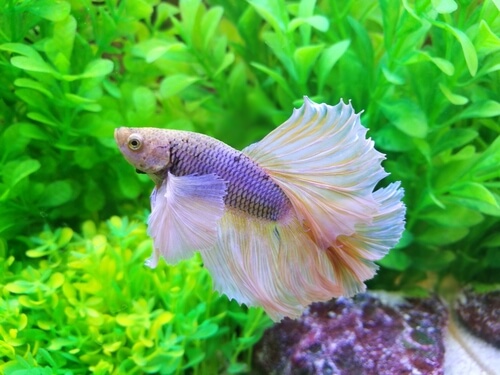
Caring for a betta, like other tropical fish, relies highly on the water quality in your tank. Your betta fish losing color is alarming, but as long as you stay aware, it shouldn’t be too bothersome to fix.
With the tips and information shared above, you should have everything you need to know about discoloration in bettas. Be sure to refer to the guide if you are unsure of the problems you may encounter.




